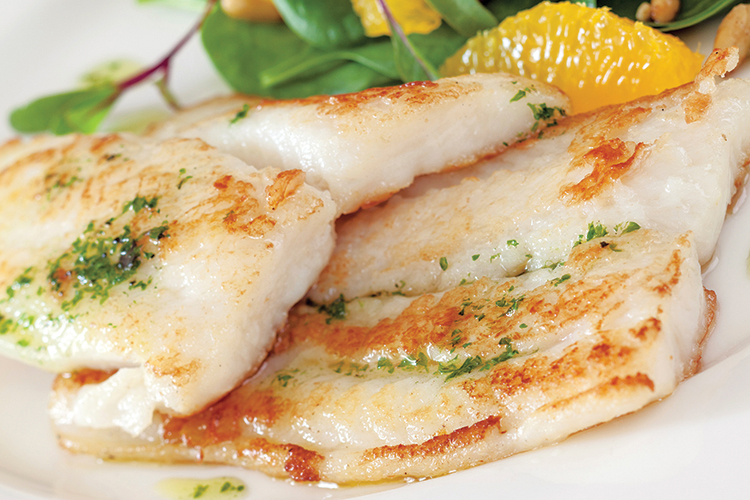Home > Virginia > Virginia Crops & Livestock > Virginia Seafood Promises Fish for Every Dish
Virginia Seafood Promises Fish for Every Dish
In partnership with: Virginia Department of Agriculture and Consumer Services

Aquaculture has seen tremendous growth in the U.S., expanding about 14-fold since 1980. As the population grows, along with seafood’s healthy reputation, aquaculture is estimated to increase in demand by 35 percent or more in the next 20 years. There’s no doubt the “Blue Revolution” is underway, and with fish farming on the rise in Virginia, the industry is set for promising years ahead.
Why Fish From Virginia Tastes Better
“In Virginia, we’ve had some outstanding aquaculture stories,” says Bill Martin, president of Blue Ridge Aquaculture. His company sells 12,000 pounds of live tilapia daily to customers located from Toronto to Washington, D.C. “We’ve shown that you can do intensive recirculating aquaculture and make a profit.”
Another success story is Virginia Cobia Farms LLC, which produces the only cobia fish in the world rated as “Best Choice” Sustainable Cobia by the Monterey Bay’s Seafood Watch program. This inland fish farm has been able to recycle fish waste into biogas energy that helps power their facility.
Over the years, Martin has watched the industry naturally progress from wild-caught to indoor farm production, the latter providing a more controlled environment for raising high-quality, protein-rich fish.
“We raise fish in the best conditions. We treat the animal well in a stress-free environment with the best diet that is known for tilapia. We do this because we want a healthy, strong fish and that equates to good taste.”
![Virginia Seafood [INFOGRAPHIC]](https://eadn-wc01-4177395.nxedge.io/wp-content/uploads/2020/05/Screen-Shot-2016-01-05-at-10.09.56-AM.jpg)
However, Martin stresses there are still a lot of hurdles. “We are competing with imports that aren’t under the same regulations that fish farmers in the U.S. face,” he says.
As many consumers make purchasing decisions based on price, cheaper imported seafood is stocking grocery stores, but at a cost.
“We get what we pay for, which in many cases is a substandard fish. We need to educate the public that seafood grown domestically is better for them. It doesn’t have harmful substances in it that may be present in substandard fish.”
Additionally, aquaculture requires capital investment and further research to advance the industry. Martin has found this goes hand-in-hand with encouraging younger generations to enter the industry and, ultimately, building a base of people who understand the commitment behind great seafood.
![Virginia Seafood [INFOGRAPHIC]](https://eadn-wc01-4177395.nxedge.io/wp-content/uploads/2020/05/Screen-Shot-2016-01-05-at-10.09.49-AM.jpg)
Shellfish Leading the “Blue Revolution”
In 2014, Virginia’s shellfish farmers sold $55.9 million in oysters and clams, an increase of 14 percent total revenue for clam growers and 33 percent for oyster growers, according to the annual Virginia Shellfish Aquaculture – Situation and Outlook Report (March 2015). Karen Hudson, commercial shellfish aquaculture extension specialist at Virginia Institute of Marine Science, says this growth can be attributed to a variety of factors, including lack of availability in other clam-producing states and the local food movement.
“The oyster industry is a younger industry and experiencing unbridled growth lately,” Hudson says. “For the last several decades, the cultured hard clams have been the dominant product in the market.” Then in 2008-09, there was a boost in oyster production and each year since has had an increase in sales and people planting oysters, taking after the clam model.
“We estimate over $100 million in economic impact to Virginia from farmed shellfish. That equates to nearly 1,000 jobs, many in rural communities.”
In addition, shellfish provide an ecological service by filtering the nutrient rich waters of the Chesapeake Bay.
“Virginia will remain the nation’s leader in hard clam production and the shellfish culture industry will continue to provide a safe and high-quality product,” Hudson says, attributing this success to a proactive industry and business-friendly regulatory structure.
Of course, Virginia’s fish farmers have one final advantage driving future success – the perfect geographic location – a highly populated corridor of the world, near coastal habitats and people who love seafood.



